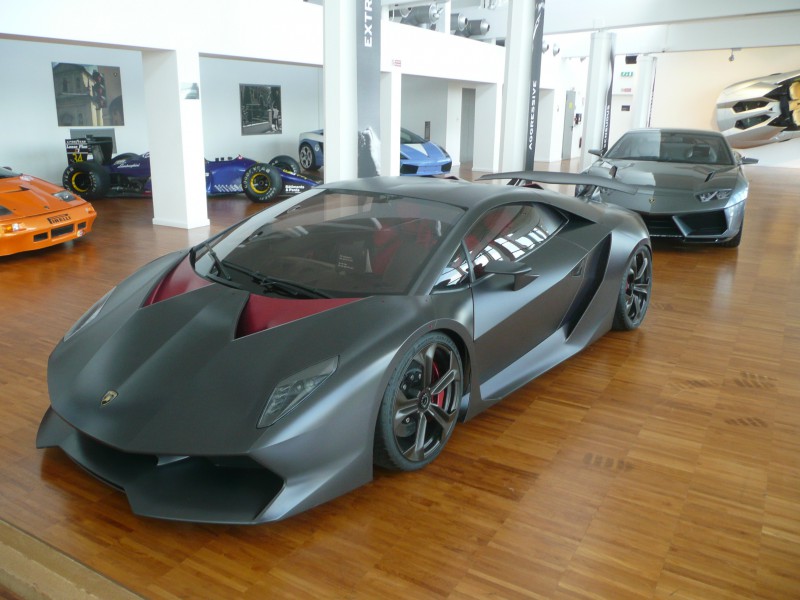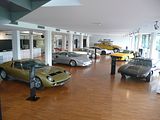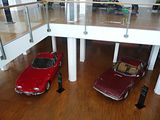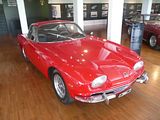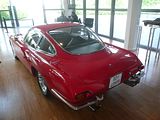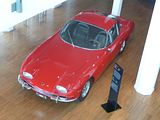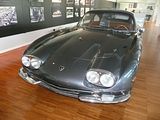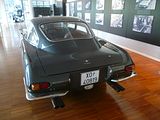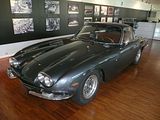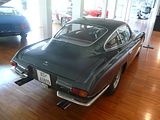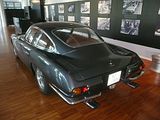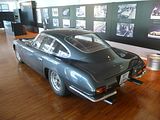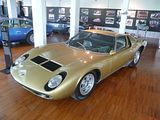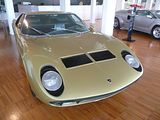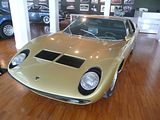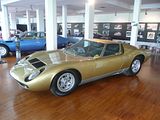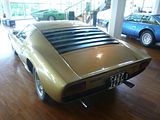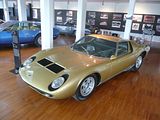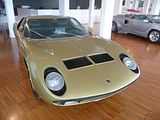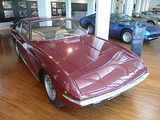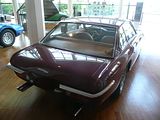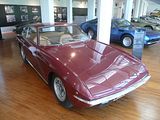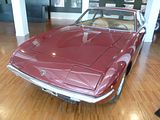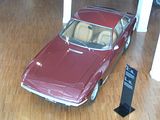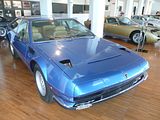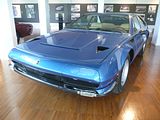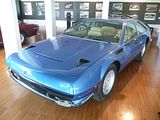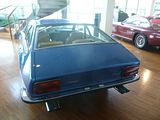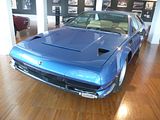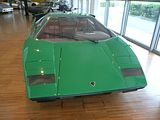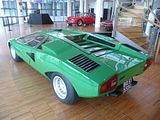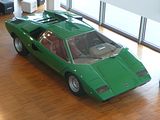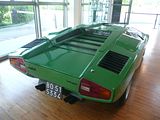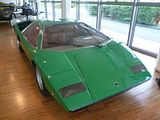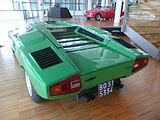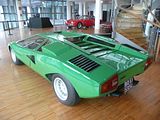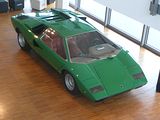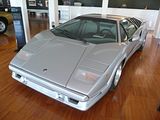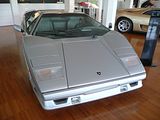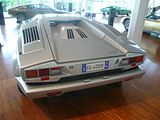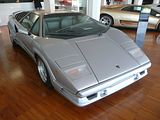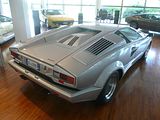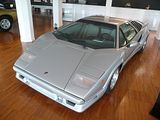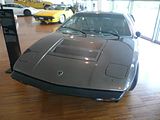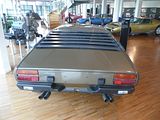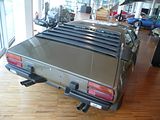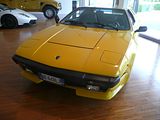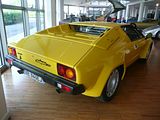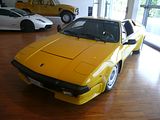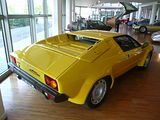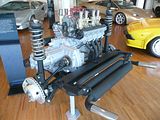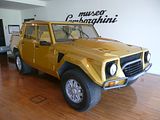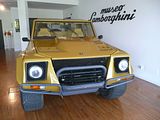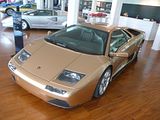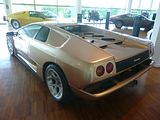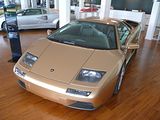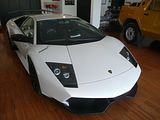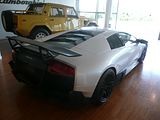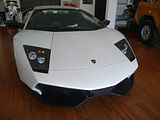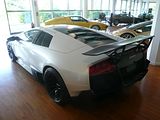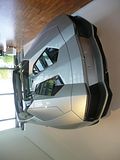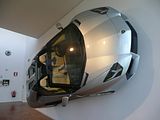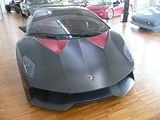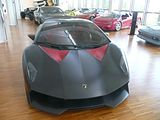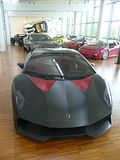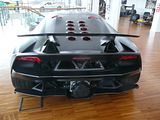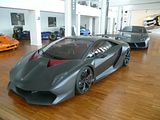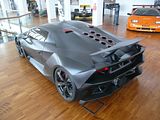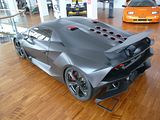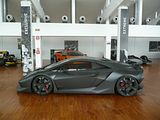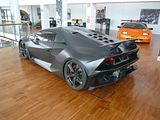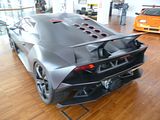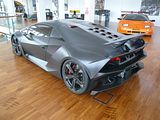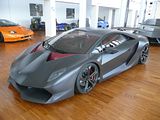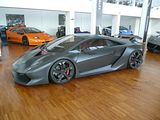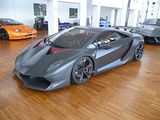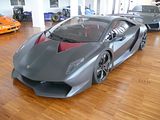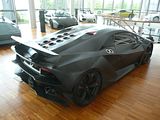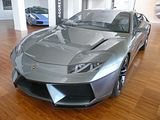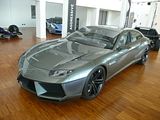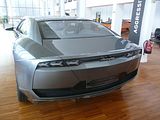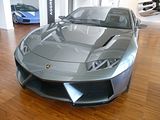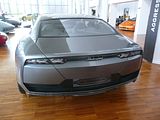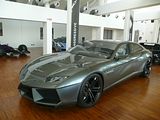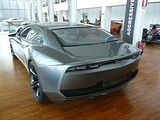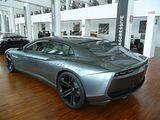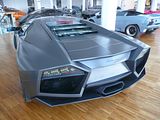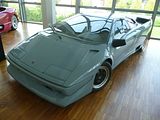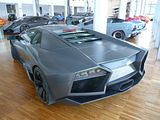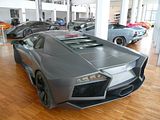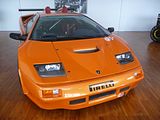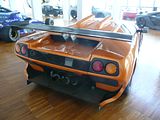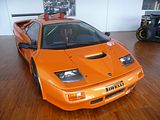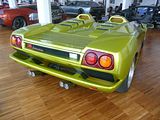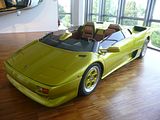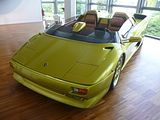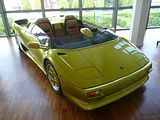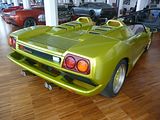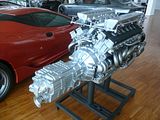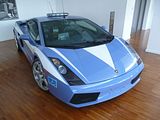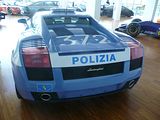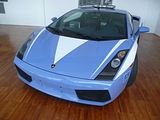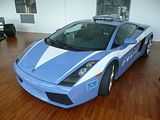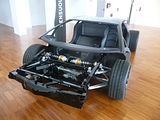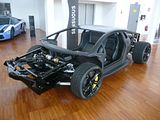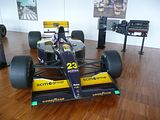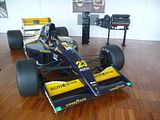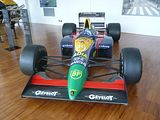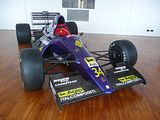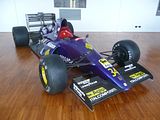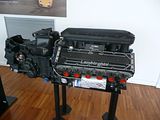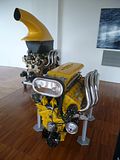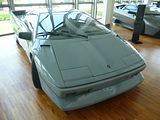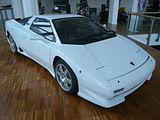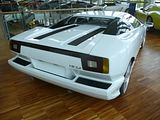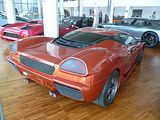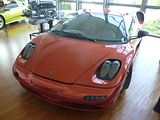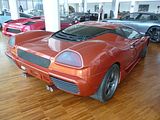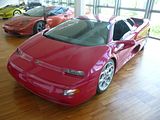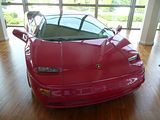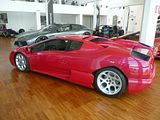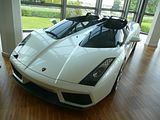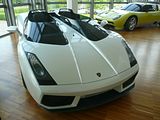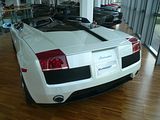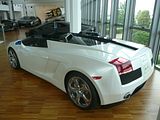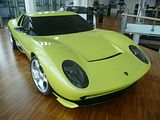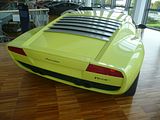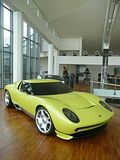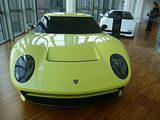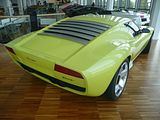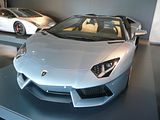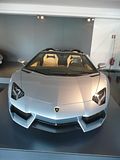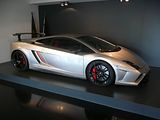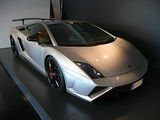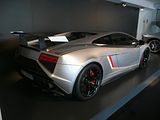I made my first visit to Sant’Agata da Bolognese when on vacation in the area in the summer of 2010. After spending a morning in the crowds at the nearby Galleria Ferrari, it had come as quite a contrast to arrive in this small town, in a very rural setting to find the large Lamborghini factory by the side of the road, to drive in through the main gate, and park up, and have the museum almost all to myself. There were examples of just about all the different models that Lamborghini have offered since the start of car production in 1963, along with a number of concept and one-off vehicles. I enjoyed the visit very much, so it was not hard to decide when back in the area to make a return trip, to see what had changed. The answer is that many of the cars that I saw in 2010 were still there, moved around very slightly, but there were also some different exhibits, not least because Lamborghini have a few vehicles now that did not exist back in 2014. So I make no apologies for presenting a new report on this museum, which you may wish to compare and contrast with what was on offer four years ago.
As before, there were not many people also enjoying the experience, so there was a sort of tranquility to the museum, punctuated by the excitement mainly from small children, and the click of various photographic devices recording the visit. From time to time the silence would be punctuated as a newly completed car came out of the gates and headed down the road for a road test. I saw at least one Huracan and a couple of Aventadors do this whilst I was there. The scurity guard who greets you on arrival points you at the visitor car park, which as it was last time was filled with Audi company cars, all with IN (Ingolstadt) plates on them, so you cannot stray far to see what else you can fin Entry to the museum costs €13.00, and to any enthusiast, it is money well spent. The museum is not that large, and you can see most the ground floor from the place where you pay your admission fee. The exhibits are beautifully laid out, and you can get right around all of them. There are information plaques by each car, in Italian. English German, with a few salient facts about the exhibit.
The first roadcar built by Lamborghini was the 350GT. Introduced in 1963, this very elegant machine was made for a couple of years during which time 120 were built.
Follow on model was the 400 GT 2+2, which was an adaption of the earlier car, but with a larger engine, and most easily recognised by the change to twin circular headlights from rectangular units. All but 23 of the 250 car production run had rear seats of sorts, though they were not exactly made for adults to spend long there.
In 1966, Lamborghini stunned the world with the dramatically styled Miura, and even now this is one head turning car. With this car, a long tradition of naming the cars after famous Spanish bulls was also born. 338 cars were produced between 1966 and 1970. Of these, 275 were the initial P400 model which put out 350 bhp, whilst this one is the later P400S model which generated 370 bhp, far fewer of which were made.
In 1968. Lamborghini came up with a new design, to complement the Miura and to replace the 400GT, this very elegant and rather underrated sports GT, called the Islero. Blisteringly fast, it could house 4 adults and a decent amount of luggage. 225 of them were made, of which 70 were the even more potent S car before production ceased in favour of the Jarama.
The Espada had a production run of 10 years, from 1968 – 1978, and over 1200 of these cars were produced in the three different series. Sadly, there was not an example of the Espada on show at the time of this visit (April 2014).
The Jarama first appeared in 1970, as the replacement for the Islero Another fast four seater, 327 of these were bult over a 4 year period, 70 of which were the S model, like this one, which sported a revised interior.
The Countach first made an appearance, as a concept in 1971, but it was 1973 before the production car made its debut, and despite unfortunate timing with fuel shortages and a recession, the car sold well throughout its production life. This is the very first example of the early production LP400 model, of which 152 were made. Incidentally, LP stands for Longditudinal Posteriore, in other words nothing more exotic than the location of the engine, an orientation that has featured in every Lamborghini since. The Countach stands at little more than 1 metre tall. No wonder they were so hard to get in and out of!
This is the very last of 658 Countach 25th Anniversary models that were made, produced to mark the quarter centenary of the firm, in 1988. It was completed on 4th July 1990, and marked the end of Countach production, in favour of the new Diablo.
Lamborghini had been toying with the idea of a smaller and cheaper car, powered by a V8 engine, to rival the smaller Ferraris, and the result – badly timed thanks to the 1973 Oil Crisis, was the launch in 1974 of the V8 powered Urraco. A low powered 2 litre version was produced to meet the challenges of Italian tax law, but other markets saw cars with bigger engines, such as this one, a P250 model. 795 were made before the car was altered to become the Silhouette.
There was not an example of the Silhouette on show, but the car which it mutated into, the Jalpa, was there. Launched in 1982, this model had a larger 3.5 litre V8 engine and further revisions to the styling. 410 cars were sold, making it the most successful V8 Lamborghini there has been.
Following a bold attempt at producing a mid engined off-roader in 1977, the LM001, sometimes known as the Cheetah, which never really achieved anything, Lamborghini revived the project in the 1980s, to produce what we would now know to be a large SUV, the LM002, in 1986, and sold more of them than I had realised, 301 in total. This is still a sizeable vehicle even by todays standards.
After several false starts at creating a replacement for the Countach, a new car finally appeared in 1990, the Diablo. This even more dramatically styled car sold in greater numbers, with the 1000th car being produced after only a few years, and 2898 cars beating the Diablo name were made in total. A number of different models were offered during the 11 year life of the car. The Diablo 6.0 SE was to be the final model, of which just 42 were produced. It was only available in this gold and a sort of brown colour.
The Murcielago debuted in 2001, and has sold well. This is the R GT model.
The upper floor of the museum contains a tantalising array of concept and (very) limited production cars, which makes it even more special than the ground floor, if you think that is possible.
Your eye is immediately caught by the fact that there is a wall mounted car at the far end of the displays. Even from a distance, it is clear that this is an Aventador Spider.
Needless to say, though it is the car in the very centre of the gallery which attracts most attention. For there is a Sesto Elemento. Having seen one of these at its launch at the 2010 Paris Show, I assumed that I would not get to see another one again, but not only do I get a second sighting, but you can go right up to this one for a much closer look. It is far more compact than any other recent Lamborghini, but still manages to look bold and menacing. Twenty of these cars were built last year, all intended for track use, and they were sold at prices ranging from US$2.2 – 2.9 million.
Parked up right behind it is a car which sadly remains a concept, the four door Estoque. I recall seeing this one at the Paris 2008 Show and gazing at it for some time. It did not move to production as the accountants felt that there was no business case to build it, with the focus shifting to SUVs (something like the Urus, which was not on display is widely rumoured to be under development for launch in a couple of years). I still think this is a very striking looking car, and it has enormous appeal as a way of transporting 4 adults across a continent in style and at speed.
Lamborghini did build 20 examples of the Reventón following its debut at the 2007 Frankfurt Show. All were finished in this matt grey paintwork, and all have All Wheel Drive.
Dating from 1998, this Diablo GT2 was designed to compete in the GT2 championship. Although based on the road car, it featured many unique parts, most of which were made from lightweight materials. The body was mainly carbon fibre, and it presaged the road-going Diablo GT that was launched soon after.
In 2004, a special Polizia version of the recently launched Gallardo was produced, and the car, complete with all sorts of special equipment from a heart defibrilator to links to the Italian police licence plate data base. It saw service on the busy A1 Autostrada between Milan and Roma. I have travelled on part of that route, from Firenze to Modena, and can say that speeding is not really the issue, as the autostrada climbs high up through the mountains and one of the two lanes is filled with lorries! A second car was built in 2005, and this went to the the Polizia Stradale in the neighbouring region of Emilia Romagna.
Although primarily known for their road cars, in the late 1980s, Lamborghini had a brief flirtation with Formula 1, supplying engines both to cars with their own name on them, and to a number of other teams as well – Minardi, Lola-Larousse, Ligier and Lotus. A couple of these cars were on show, the 1992 M.191/L Minardi and the 1989 Lola-LaRousse. The former was driven by Christian Fittipaldi, Alex Zanardi and Giovanni Morbidelli and this car scored points in its first outing at the Brazilian Grand Prix. In 1991, Lamborghini undertook work on a new engine design, with the planned client being McLaren, but in the end, the British team decided to source their engines elsewhere. Chrysler brought the Lamborghini F1 story to a close at the end of the 1993 season, after participating in 80 Grand Prix.
Although Lamborghini are best known for their cars, they have also built engines for powerboats, and there were a couple of these on display. This L900 unit has a capacity of 9.3 litres, from 12 cylinders, and was coupled to a 6 speed transmission, It generated a not inconsiderable 650 bhp.
This L804 unit, dating from 1993 has a slightly smaller cubic capacity, at 8.2 litres, also in a V12 format, but it put out 1100 bhp, which was enough to power the Class 1 Offshore World Championship winning powerboat.
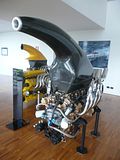
During the 1980s and 1990s, Lamborghini experienced some fairly difficult times, facing bankruptcy more than once, and after being acquired by Chrysler Corporation in 1987, only found stability following their take-over by Audi in the late 1990s. Numerous prototypes were produced, but none of these cars made production, so it was good to see several of them in the museum
This is the LP140, planned as a potential replacement for the V8 models. It was designed by Gandini, and featured Lamborghini’s first V10 powerplant. Plans to put it into production were well advanced, but new owners Chrysler decided against the project, and it died. It was not for another 15 years before a “small” Lamborghini, the Gallardo, would join the range.
When it came to replacing the Diablo, two rival alternatives were produced. Known as P147, or Canto both Zagato and Gandini produced proposals. The Gandini version retained many of the parts of the Diablo such as the roof, windows and doors. New owners, Audi, decided against both cars, and what eventually emerged was the very different Murcielago.
This Gallardo based concept car, the Concept S, dates from 2005. Styled by Luc Donkerwolke, it is based on a Gallardo, but with a particularly innovative solution to the roof for the driver and passenger.
To celebrate the 40th anniversary of the launch of the Miura, a car that many think of as the very first supercar, Walter da Silva was tasked in 2006 with coming up with a modern recreation, and this is the result. I think it looks absolutely terrific, combining modern styling cues with that retro feel. Sadly, only 1 such car was made, and the idea went no further.
There is a shop selling Lamborghini branded goods in the main building next door, and you will also find a couple of display cars in this building, which were an Aventador and one of the last Gallardos made.
I do strongly recommend a visit to this Museum. Bologna is the nearest airport, but it is pretty accessible from Florence/Tuscany, which was my starting destination. You could easily do this in the morning and Maranello in the afternoon, or vice versa. Santa’Agata is mid-way between Bologna and Modena, on the SP255 road, a few kilometres north of the main A1 autostrada. Although the village is signed, there are no specific signs to the museum (unlike the Ferrari museums which have tourist signs all over the place).
More details on the museum can be found on the official website: http://www.lamborghini.com/en/museum/overview/

